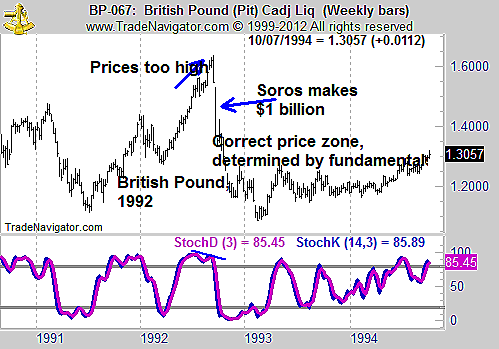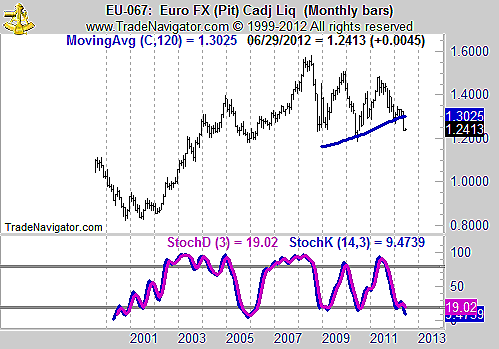
HOT TOPICS LIST
- MACD
- Fibonacci
- RSI
- Gann
- ADXR
- Stochastics
- Volume
- Triangles
- Futures
- Cycles
- Volatility
- ZIGZAG
- MESA
- Retracement
- Aroon
INDICATORS LIST
LIST OF TOPICS
PRINT THIS ARTICLE
by Mike Carr, CMT
The investing legend is in the news discussing the euro. Traders can study his past success for valuable insights.
Position: Sell
Mike Carr, CMT
Mike Carr, CMT, is a member of the Market Technicians Association, and editor of the MTA's newsletter, Technically Speaking. He is also the author of "Smarter Investing in Any Economy: The Definitive Guide to Relative Strength Investing," and "Conquering the Divide: How to Use Economic Indicators to Catch Stock Market Trends."
PRINT THIS ARTICLE
STOCHASTICS
George Soros: Closet Technician?
06/07/12 08:46:45 AMby Mike Carr, CMT
The investing legend is in the news discussing the euro. Traders can study his past success for valuable insights.
Position: Sell
| George Soros is a hedge fund investor who has made billions for himself and his investors. His investment style is difficult to define. He uses futures, currency markets, individual stocks and exchange traded funds (ETFs). There are probably other investments that he owns that do not require disclosure. His success has been steady over many years, although his reputation is largely based on one of the greatest trades in history. Soros is the trader who "broke the Bank of England" in 1992, and studying that trade (Figure 1) could offer some insight into his trading. |

|
| FIGURE 1: BRITISH POUND, WEEKLY. The British pound helped establish Soros’ reputation as one of the greatest traders of all time. He was selling short near the peak in 1992. |
| Graphic provided by: Trade Navigator. |
| |
| Soros deals largely with macroeconomic trends. The idea underlying this trade was that the Bank of England would be unable to maintain a peg that would allow the country to remain part of the European rate mechanism, a precursor to the euro. Soros believed that the British pound would not be a part of the euro and he bet heavily on that, going short as the price went up in the summer of 1992. His billion-dollar payoff came after he had accumulated a position worth about $10 billion, and the slight uptick before the collapse of the pound undoubtedly caused some concerns. On the weekly chart, the stochastic is shown and there was a small bearish divergence going into that top. The daily chart shows that the stochastic gave a sell signal the day before. |
| More instructive than a review of indicators from that chart is a consideration of the investment philosophy that Soros described in his 1987 book, "The Alchemy Of Finance: Reading The Mind Of The Market." There are no clear formulas in the book, just a mention of the fact that markets follow a stochastic process and a discussion of what Soros called the theory of reflexivity. Reflexivity is the idea that he credits with helping him uncover the largest trends in the market. Reflexivity seems to begin with the idea that markets move between states of disequilibrium in the short term. This is different than the efficient market hypothesis (EMH), which Soros says he had no time to study because he trades the markets and doesn't have time for ideas that don't work. The EMH says prices are usually trying to find equilibrium and are usually near their true underlying value. Reflexivity applies the idea that prices move from one extreme to another or from a price that is too high to one that is too low. In the long run, fundamentals dictate the true price and the long-term trend, but Soros is looking for extremes from which he can derive short-term profits. |
| In a recent speech, Soros said that the euro needs to be fixed in three months. That could indicate that the time to trade the euro is now. Figure 2 shows a long-term chart to offer perspective on where we might be in the theory of reflexivity. The 120-month moving average (the blue line) has been added to the chart and the euro has just fallen below that average. The euro began trading in 1999, so there is only a limited price history. The crisis brings the euro to a point where a large move is likely. Reflexivity says that the move will correct a market excess. Since the euro has been strong for most of its history, the reflexive move would be down. |

|
| FIGURE 2: EURO, MONTHLY. The euro has been stronger than the dollar for most of its trading history. |
| Graphic provided by: Trade Navigator. |
| |
| The stochastic is bearish, the euro is below its 10-month moving average, and it is trading at the lower end of a five-year trading range. A short trade offers the most likely way to profit in this environment. |
Mike Carr, CMT, is a member of the Market Technicians Association, and editor of the MTA's newsletter, Technically Speaking. He is also the author of "Smarter Investing in Any Economy: The Definitive Guide to Relative Strength Investing," and "Conquering the Divide: How to Use Economic Indicators to Catch Stock Market Trends."
| Website: | www.moneynews.com/blogs/MichaelCarr/id-73 |
| E-mail address: | marketstrategist@gmail.com |
Click here for more information about our publications!
Comments

|

Request Information From Our Sponsors
- StockCharts.com, Inc.
- Candle Patterns
- Candlestick Charting Explained
- Intermarket Technical Analysis
- John Murphy on Chart Analysis
- John Murphy's Chart Pattern Recognition
- John Murphy's Market Message
- MurphyExplainsMarketAnalysis-Intermarket Analysis
- MurphyExplainsMarketAnalysis-Visual Analysis
- StockCharts.com
- Technical Analysis of the Financial Markets
- The Visual Investor
- VectorVest, Inc.
- Executive Premier Workshop
- One-Day Options Course
- OptionsPro
- Retirement Income Workshop
- Sure-Fire Trading Systems (VectorVest, Inc.)
- Trading as a Business Workshop
- VectorVest 7 EOD
- VectorVest 7 RealTime/IntraDay
- VectorVest AutoTester
- VectorVest Educational Services
- VectorVest OnLine
- VectorVest Options Analyzer
- VectorVest ProGraphics v6.0
- VectorVest ProTrader 7
- VectorVest RealTime Derby Tool
- VectorVest Simulator
- VectorVest Variator
- VectorVest Watchdog
